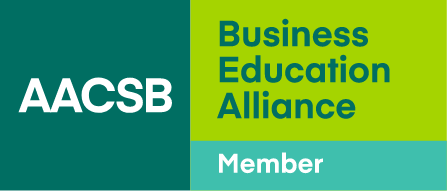General Accreditation
FAQs - General Accreditation
Where can I find out if a school is accredited?
A complete listing of accredited members is available here. It is our policy not to disclose the names of schools currently in the process of seeking accreditation. A complete list of member institutions may be found here. Please see our membership pages for an overview of AACSB membership and the various membership options available.
Membership, however, does not denote AACSB Accreditation and should not be interpreted as achieving accreditation. Accreditation is granted only to those institutions which have undergone a lengthy peer review process and been found to satisfy the Guiding Principles and Standards for accreditation.
Membership, however, does not denote AACSB Accreditation and should not be interpreted as achieving accreditation. Accreditation is granted only to those institutions which have undergone a lengthy peer review process and been found to satisfy the Guiding Principles and Standards for accreditation.
My school is accredited, how can we promote it? Can we use the accreditation seal?
AACSB does not require prior permission to use the seal, nor do we require a review of your marketing materials. As an AACSB-accredited institution, we encourage you to use the accreditation seal, which you can find in your my.aacsb.edu account along with the AACSB brand guidelines.
Earning AACSB Accreditation is a significant accomplishment, and we encourage you to promote your achievement—in print, on your institution's website, and around campus.
Earning AACSB Accreditation is a significant accomplishment, and we encourage you to promote your achievement—in print, on your institution's website, and around campus.
Does accreditation cover the whole institution or just the business school?
By default, AACSB Accreditation is granted to the entire institution. Under institutional accreditation, all business degrees within the institution, regardless of whether they are housed within the business school or elsewhere in the university, are to be included in the scope of the AACSB accreditation review, unless otherwise excluded. It is possible, in the case of institutional accreditation, to request the exclusion of certain degree programs which are below the established thresholds of traditional business content (25 percent or more for baccalaureate degree programs and 50 percent or more for post-baccalaureate degree programs). A form must be completed for each program a school wishes to exclude.
AACSB staff members approve common exclusion requests. However, questionable program exclusion requests will be forwarded to the appropriate operating committee (IAC, CIRC, AAC).
In contrast to institutional accreditation, schools may apply as a single academic unit within a larger institution offering business and management degree programs. Business academic units that would like to enter the accreditation process as the unit of accreditation must submit a Unit of Accreditation Application for review and approval by the Initial Accreditation Committee (IAC). This application must be approved prior to the submission of the eligibility application. More in-depth information on the unit of accreditation can be found here.
AACSB staff members approve common exclusion requests. However, questionable program exclusion requests will be forwarded to the appropriate operating committee (IAC, CIRC, AAC).
In contrast to institutional accreditation, schools may apply as a single academic unit within a larger institution offering business and management degree programs. Business academic units that would like to enter the accreditation process as the unit of accreditation must submit a Unit of Accreditation Application for review and approval by the Initial Accreditation Committee (IAC). This application must be approved prior to the submission of the eligibility application. More in-depth information on the unit of accreditation can be found here.
What is the difference between Initial Accreditation Committees Y and Z?
There is no substantive difference in the IAC-Y and IAC-Z committees. You can submit your reports to either group. However, it is suggested that when you submit to either the Y or Z committee, you remain with that committee for the duration of the initial accreditation process.
As a learner, where can I find a school or program that is right for me?
For information on AACSB-accredited schools and degree programs, we encourage you to visit the Learner section of our website to explore programs that might fit your needs and goals.
Does AACSB accredit fully online programs and hybrid/blended programs? What are the criteria for these programs?
Many of the institutions accredited by AACSB offer blended and online programs. AACSB International does not dictate the modality through which a program must be delivered. Standard 2 provides the following guidance:
Basis for Judgment
2.2 Virtual Resources
Basis for Judgment
2.2 Virtual Resources
- The school provides infrastructure to support its instructional activities for all modalities.
- Faculty have access to sufficient current and emerging technologies for both teaching and research purposes consistent with their mission, strategies, and expected outcomes. Such access may be realized through partnerships with other schools or other third parties.
- Professional staff are provided adequate training and technology infrastructure for advising, career placement, and other mission-specific activities.
Can you provide sample degree curriculum plans that satisfy AACSB requirements?
AACSB's standards are not prescriptive in terms of specific courses that a certain degree program should include. Curriculum content is addressed in Standard 4. This standard outlines core competencies, skills, and experiences that would typically be included in a business degree program. s AACSB does not have a standard curriculum to which we expect schools to adhere; schools have the latitude to formulate curricula that is best for the mission of their school and the learner population it serves.
Does AACSB verify or evaluate foreign transcripts for learners wishing to study in the United States?
AACSB does not evaluate transcripts. However, there are a number of organizations that offer evaluation services. The National Association of Credential Evaluation Services is a member organization comprised of organizations that offer such services. For a complete listing of their members, visit their website here.
Why does AACSB ask for a list of peer, competitive, and aspirant schools? How can I define that list?
From the Initial Accreditation handbook, "Processes to support the accreditation review include the selection of comparison groups to form a relevant context for judgments, inform strategic planning activities, and assist in the selection of peer review team members. Reviewers from comparable institutions are better prepared to make evaluative judgments about the school, to understand the school and its aspirations, and to offer suggestions for the school’s improvement.”
Schools can identify these groups themselves or use DataDirect to assist in their efforts. You can find DataDirect FAQs and online tutorials here.
Schools can identify these groups themselves or use DataDirect to assist in their efforts. You can find DataDirect FAQs and online tutorials here.
Is an AACSB AI GPT or chatbot that I found online legitimate?
Please be aware of unauthorized AI GPTs (Generative Pre-trained Transformers) impersonating AACSB International, using our logo, and offering advice under false pretenses. These impostor GPTs are not endorsed by or affiliated with AACSB. They pose significant risks to your data security and may not provide accurate advice.
Any GPT created and published by AACSB International will:
- Be clearly identified within the GPT as the official GPT for AACSB.
- Be accessed from the AACSB website.
- Include a designated contact person to address any questions or concerns you may have.
- Be fully compliant with AACSB privacy and security policies.
If you encounter a suspicious GPT claiming to represent AACSB, please report it to [email protected] immediately.





